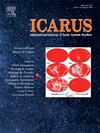火星环克里斯南部平顶混乱地形形成的时间
IF 3
2区 物理与天体物理
Q2 ASTRONOMY & ASTROPHYSICS
引用次数: 0
摘要
火星上大量流出通道的存在凸显了火星的动态水文历史。混沌地形已被确定为负责雕刻这些通道的洪水的源区,但由于有关水排出机制和地形变形演变的未解决问题,它们仍然是一个谜。利用最新的CTX, HRSC和MOLA数据集以及数字高程模型(DEM)和三角不规则网络(TIN),我们检查了平滑的混沌地形,包括hydrotes Chaos, Hydaspis Chaos中的陨石坑对,Baetis Chaos和Candor Chaos,都位于Chryse Planitia南部。我们的研究结果表明,这些混乱地形的崩溃主要由局部过程控制,而不是由区域影响控制。此外,证据支持这样的结论,即最大的混沌地形可以通过多种机制进行,而不仅仅依赖于地壳加热或局部火山活动等热源,它们的形成跨越了中诺亚纪到晚赫斯perian/早期亚马逊。这些结果通过强调局部地质条件在混沌地形演化中的重要性,完善了我们对火星表面过程的理解。大面积破碎的“混乱地形”被认为是一些洪水的来源区域,这些洪水负责在火星表面雕刻出巨大的沟渠。在这项研究中,我们使用轨道图像创建了火星水手谷及其周围4个混乱地形位置的表面3D模型。我们的研究结果表明,混沌地形是由局部机制形成的,而不是由区域尺度的构造控制。此外,最大的混沌区域不需要外部热源的额外热量来触发它们的坍缩,它们形成的时间跨度比之前认为的要长得多。这项工作有助于阐明当地条件如何影响火星表面的演变。本文章由计算机程序翻译,如有差异,请以英文原文为准。
Timing of smooth-topped chaotic terrain formation in southern Circum-Chryse, Mars
The presence of large outflow channels on Mars underscores the planet's dynamic hydrologic history. Chaotic terrain has been identified as the source regions for the floodwaters responsible for carving these channels, however they remain enigmatic due to unresolved questions regarding the mechanisms of water expulsion and the evolution of terrain deformation. Utilizing the latest CTX, HRSC, and MOLA datasets alongside Digital Elevation Models (DEM) and Triangulated Irregular Networks (TIN), we examined smooth-topped chaotic terrain including Hydraotes Chaos, a crater pair in Hydaspis Chaos, Baetis Chaos, and Candor Chaos, all located south of Chryse Planitia. Our findings indicate that the collapse of these chaotic terrain is predominantly controlled by local processes rather than by regional influences. Furthermore, the evidence supports the conclusion that the largest chaotic terrain can proceed by multiple mechanisms and is not solely reliant on heat sources such as crustal heating or local volcanism and that their formation spanned from the Middle Noachian to the Late Hesperian/Early Amazonian. These results refine our understanding of Martian surface processes by emphasizing the significance of localized geological conditions in chaotic terrain evolution.
Plain English Abstract
Large areas of broken up ‘chaotic terrain’ are thought to be the source regions for some of the floodwaters responsible for carving large channels on the surface of Mars. In this study we use orbital images to create 3D models of the surface of 4 chaotic terrain locations in and around Valles Marineris, Mars. Our findings suggest that the chaotic terrain are formed by local mechanisms, rather than being controlled by regional-scale tectonics. In addition, the largest chaotic areas did not need extra heat from external sources to trigger their collapse, and they formed over a much longer time span than previously thought. This work helps clarify how local conditions influenced the evolution of Mars' surface.
求助全文
通过发布文献求助,成功后即可免费获取论文全文。
去求助
来源期刊

Icarus
地学天文-天文与天体物理
CiteScore
6.30
自引率
18.80%
发文量
356
审稿时长
2-4 weeks
期刊介绍:
Icarus is devoted to the publication of original contributions in the field of Solar System studies. Manuscripts reporting the results of new research - observational, experimental, or theoretical - concerning the astronomy, geology, meteorology, physics, chemistry, biology, and other scientific aspects of our Solar System or extrasolar systems are welcome. The journal generally does not publish papers devoted exclusively to the Sun, the Earth, celestial mechanics, meteoritics, or astrophysics. Icarus does not publish papers that provide "improved" versions of Bode''s law, or other numerical relations, without a sound physical basis. Icarus does not publish meeting announcements or general notices. Reviews, historical papers, and manuscripts describing spacecraft instrumentation may be considered, but only with prior approval of the editor. An entire issue of the journal is occasionally devoted to a single subject, usually arising from a conference on the same topic. The language of publication is English. American or British usage is accepted, but not a mixture of these.
 求助内容:
求助内容: 应助结果提醒方式:
应助结果提醒方式:


